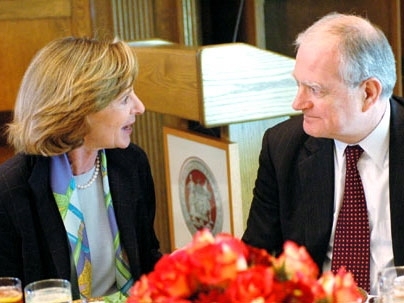President Bush's science advisor, the head of the National Science Foundation and other top scientists and engineers from around the country gathered at MIT last Thursday, Oct. 20, to push forward a national conversation on engineering education in the 21st century and the challenges, both here and abroad, that will affect it.
"One of the reasons I am here is to let you know that we are listening -- my office, and [that of] the president," said John H. Marburger, science advisor to the president and director of the Office of Science and Technology Policy.
The one-day workshop at MIT grew from issues discussed in the recent National Academy of Engineering report, "The Engineer of 2020: Visions of Engineering in the New Century," as well as National Science Board (NSB) reports that identified troubling trends such as the low number of domestic engineering students.
MIT President Susan Hockfield said that when she learned of the workshop, she was very excited because "MIT is committed to innovations in engineering education, and that's really what this workshop is about."
She noted fundamental challenges that must be addressed, such as the "challenge of interest." "Kids and Americans today fail to be inspired by engineering, by science, and by mathematics," she said, noting that only 17 percent of U.S. bachelors' degrees are in science and engineering compared to 68 percent in Singapore.
She also stressed that to move engineering forward we must "recruit aggressively" women and minorities in this country. "Engineering can't continue to be dominated predominantly by men -- by white men."
The United States continues to lead the world in science and technology. That said, "the redistribution of engineering talent is going to be the battlefield of global competitiveness in the future," said Arden L. Bement, head of the National Science Foundation. "We have an advantage. We just can't become complacent."
He further noted that if U.S. industry can find engineering talent in the developing world for 20 cents on the dollar, "they're going to do so, and probably should."
So the challenge for U.S. engineering schools is to "provide students who offer five times the value added," he said.
Commenting on the American public's sometimes negative view of the discipline, he said, "more than anything else we need a Carl Sagan-quality spokesman for engineering."
Rather than focus on federal science policy, Marburger, who's been an engineer, physicist and academic, commented on the issues involved from a personal perspective.
He stressed the importance of individual faculty members and their influence on students. "The key to improving education of any kind is [a professor's] acceptance of the responsibility [involved in] teaching students."
He noted that the "number one fact I'll take away from this morning is that 98 percent of the students who drop out of engineering cite bad teaching as the cause."
The workshop was sponsored by the NSB and hosted by the Engineering Systems Division of MIT's School of Engineering.
A version of this article appeared in MIT Tech Talk on October 26, 2005 (download PDF).






